Honda Passport Vs. Toyota Highlander
The 2024 Honda Pilot vs. Toyota Highlander are top contenders in the popular three-row SUV market. If you're here today to compare Honda Pilot trims with Toyota Highlander editions, you're in for a treat: The Pilot SUV quickly pulls ahead of its competition with a lower starting MSRP, a shockingly larger cargo volume, and many more safety features than the Highlander model.
Let's delve into this 2024 Honda Honda Pilot vs. Toyota Highlander comparison to see why the new Honda Pilot might just be the better sport ute for you.
| 2024 Honda Pilot LX | 2024 Toyota Highlander LE | |
|---|---|---|
| Engine | 3.5L V-6 | 2.4L Turbo 4-Cyl |
| Horsepower | 285 | 265 |
| Torque | 262 lb-ft | 310 lb-ft |
| Max Towing Capacity | 5,000 lbs1 | 5,000 lbs2 |
| Fuel Injection | Multi-Stage, High-Pressure Direct | D-4S Direct |
| Valve Train | 24-Valve DOHC w/ Dual Variable Timing Control | 16-Valve DOHC |
| EPA-Est. MPG (City/Hwy/Cmb) | 19/27/22 MPG3 - 2WD
19/25/21 - 18/23/20 MPG3 - AWD |
22/29/25 MPG4 - FWD
21/28/24 MPG4 - AWD |
| Max Cargo Volume (Behind 1st/2nd/3rd Rows) | 111.8 / 59.5 / 21.8 cu ft | 84.3 / 48.4 / 16 cu ft |
| Drive Modes | Normal, ECON, Snow, Tow | Sport, Eco, Normal, and Snow |
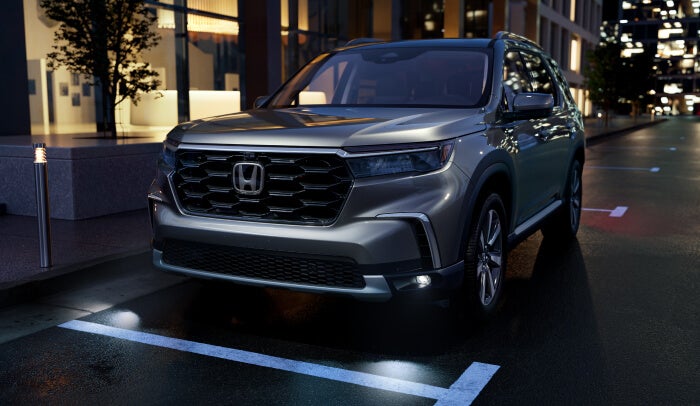
Honda Pilot vs. Toyota Highlander: Specs & Performance
One of the primary reasons you're likely comparing Honda Pilot vs. Toyota Highlander performance is to find an SUV that can handle any weather condition with ease. Out the gate, the new Honda Pilot is ready for action with up to six different Drive Modes, including Trail and Sand modes on AWD configurations.
You'll find 2WD and AWD in both sport utes, but the Honda Pilot engine – an efficient 3.5-liter V-6 with an Eco Assist System – generates 285 horsepower to increase your speed capabilities. The new Toyota Highlander is fitted with a smaller 2.4-liter turbo four-cylinder that puts out 265 horsepower.
It's worth noting that the Toyota Highlander also offers hybrid powertrains to increase your fuel efficiency, but keep in mind that these hybrid trims come at a multi-thousand-dollar upcharge. The Pilot SUV remains gas-powered across its 2024 lineup, focusing on consistent and powerful performance across all its models.
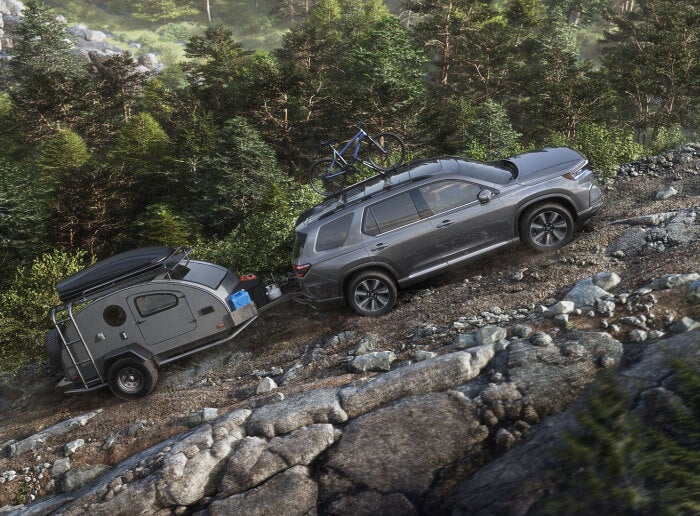
Honda Pilot vs. Toyota Highlander: Towing Capacity & Dimensions
Built for more than daily drives, the Honda Pilot and the Toyota Highlander deliver up to 5,000 pounds of towing strength when properly equipped. Outside of traditional towing specs, every model of the 2024 Pilot SUV comes with helpful trailering features like Hill Descent Control, a Tow drive mode, and even an available Trail Torque Logic system and an Integrated Class III Trailer Hitch on its TrailSport trim.
Both SUVs have ventilated front disc brakes and solid rear disc brakes for maximum control. Neither automaker offers roof rails on its base model, but you can find them on most other trim levels.
A quick glance at Honda Pilot vs. Toyota Highlander dimensions shows us that the Honda SUV is not only a full five inches longer, but it also has an incredibly larger standard and maximum cargo space, plus more second- and third-row legroom, than every Highlander trim. When optimizing your cabin storage is a priority, the Honda Pilot wins this comparison, no contest!
Since both SUVs claim to hold up to eight passengers, it's crucial to note that while the Toyota model's third row has only 28 inches of legroom – which is too small for any teen or adult to sit comfortably – the 2024 Honda Pilot gives its third-row occupants 32.5 inches of far back row legroom, making the Pilot SUV the obvious choice for families who actually need to seat passengers in every row.
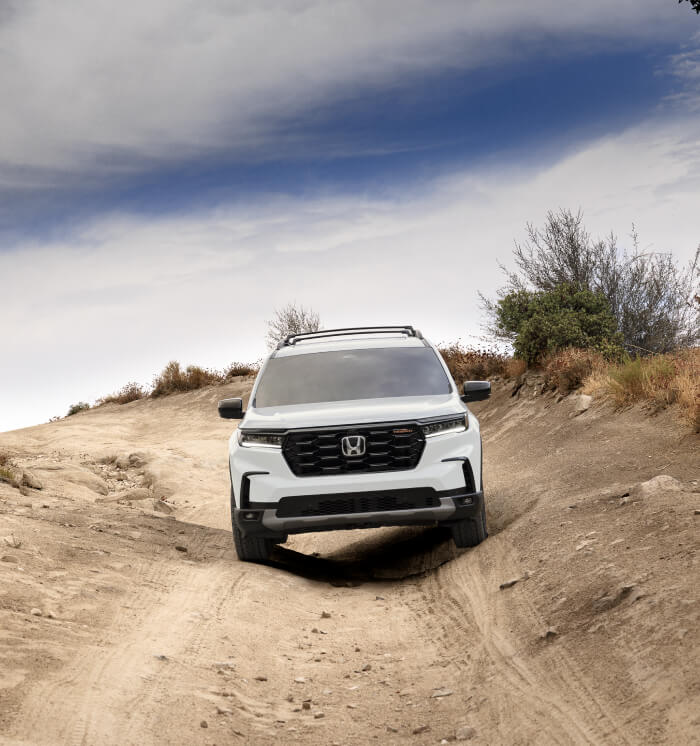
Honda Pilot vs. Toyota Highlander: Trim Levels
Choose from a diverse, six-trim Honda Pilot lineup, each with unique features to give drivers at every price point a reason to smile. From the entry-level Pilot LX to the luxurious Pilot Elite, there's a Honda SUV trim for everyone:
- Honda Pilot LX
- Honda Pilot Sport
- Honda Pilot EX-L
- Honda Pilot TrailSport
- Honda Pilot Touring
- Honda Pilot Elite
While the Highlander does offer a broader trim selection with its hybrid variants, it's important to note that these models will increase your MSRP. The standard and available features at each trim level also showcase how Honda quality wins out over Toyota quantity:
- Toyota Highlander LE
- Toyota Highlander XLE
- Toyota Highlander XSE
- Toyota Highlander Limited
- Toyota Highlander Platinum
- Toyota Highlander Hybrid LE
- Toyota Highlander Hybrid LE Nightshade
- Toyota Highlander Hybrid XLE
- Toyota Highlander Hybrid XLE Nightshade
- Toyota Highlander Hybrid Limited
- Toyota Highlander Hybrid Platinum
Both the Honda SUV and the Highlander trims start their entry models with touch screens, digital information screens, three-zone climate control, and USB charging ports, and they both add wireless device charging at higher trim levels. However, only the Honda Pilot gives you standard Speed-Sensitive Volume, a hidden storage well, and cargo area bag and garment hooks.
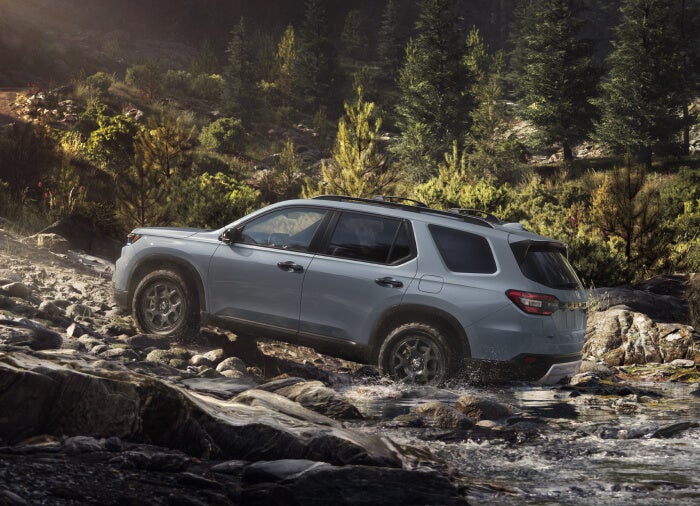
Honda Pilot vs. Toyota Highlander: Safety Features
The Honda name is synonymous with top-shelf safety features, and the new Pilot SUV is a prime example of this commitment to customer protection. Every 2024 Honda Pilot trim comes with Honda Sensing Technologies that work harmoniously to help keep you secure and confident on the road. You'll also find head restraints in every Honda Pilot seating position, which is extremely important to occupant safety (a detail that the Toyota Highlander forgot).
A Multi-Angle Rearview Camera with Dynamic Guidelines comes standard on the new Honda Pilot, as do tech-forward alerts like Forward Collision Warning, Lane Departure Warning, a Cross-Traffic Monitor, and front and rear parking sensors. Gain navigational support through Traffic Jam Assist and Adaptive Cruise Control with Lower Speed Follow. The bottom line is that the new Honda Pilot truly is elevating midsize SUV safety standards, while the Toyota model falls short.
The 2024 Toyota Highlander comes with Toyota Safety Sense 2.5+, a system that sounds high-end in name but delivers far fewer features. Outside of the expected driver-assist tools like a Tire Pressure Monitor System, Hill Start Assist, a LATCH child seat system, and a Blind Spot Monitor (all of which every trim of the Honda Pilot also has), you won't find much else in the new Highlander SUV. No Traffic Jam Assist to help shorten your drive times and no standard backup camera with dynamic gridlines in any of the first three Toyota trims.
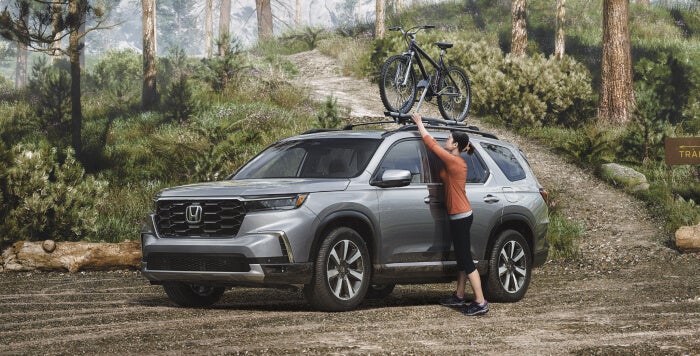
Discover SUV Excellence in Your 2024 Honda Pilot
Experience the unmatched quality of the new Honda Pilot today when you visit our dealership! Though both contenders are popular in the SUV market, the Honda Pilot relieves the stress of daily life with its incredible cargo storage, multi-drive mode performance, and elevated safety features. While you're here, you can compare other Honda models or browse online with our helpful Honda Pilot vs. Honda Passport comparison.
Need to discuss leasing or financing options? Contact DARCARS Honda Bowie, MD to discuss our current specials, determine a trade-in value, or explore our service and maintenance deals. No matter your financial situation, our team can help you discover the perfect Honda SUV for your needs. Stop by today!
Frequently Asked Questions
Does the Honda Pilot or the Toyota Highlander have more cargo space?
It's almost unbelievable how much more cargo space the Honda Pilot offers. Behind the first, second, and third rows, the 2024 Honda Pilot provides the most cargo storage, with a standard trunk space of 18.6 to 22.4 cubic feet, depending on the position of your third-row seating. The Toyota Highlander makes daily errands more difficult with its minuscule 16 cubic feet of standard trunk storage.
Is a Honda Pilot bigger than a Toyota Highlander?
Yes, the 2024 Honda Pilot is a full five inches longer and 2.5 inches wider than the Toyota Highlander, and these exterior discrepancies are very evident in passenger legroom and cargo storage. The Pilot SUV stretches 199.9 inches long (or 200.2 inches in the TrailSport trim) and 78.5 inches wide. Comparatively, the new Toyota Highlander measures 194.9 inches long and 76 inches wide.
What is the interior space of a Honda Pilot compared to the Toyota Highlander?
The 2024 Honda Pilot maximizes interior space to give front-seat passengers up to 40.5 inches of headroom and 41 inches of legroom. This spacious pattern continues with third-row passengers enjoying 32.5 inches of legroom across all trims. The Highlander SUV is much smaller, with most trim levels offering 39.6 inches of front headroom and a cramped 28 inches of third-row legroom.
1Towing requires accessory towing equipment. Please see your Honda dealer for details.
2Before towing, confirm your vehicle and trailer are compatible, hooked up and loaded properly and that you have any necessary additional equipment. Do not exceed any Weight Ratings and follow all instructions in your Owner's Manual. The maximum you can tow depends on base curb weight plus the total weight of any cargo, occupants, and added vehicle equipment. "Added vehicle equipment" includes additional standard/optional equipment and accessories added by the manufacturer, dealers, and/or vehicle owners. The only way to be certain of your vehicle's exact curb weight is to weigh your vehicle without passengers or cargo. [Calculated with the new SAE J2807 method.] Installation of a tow hitch receiver or other accessories located near the rear bumper or side-door kick sensors may require disabling or removing the kick sensor, and the sensor operation setting in your vehicle should be turned off. See Owner's Manual for limitations.
3Based on 2024 EPA mileage ratings. Use for comparison purposes only. Your mileage will vary depending on driving conditions, how you drive and maintain your vehicle, and other factors.
4Use for comparison purposes only. Your mileage will vary for many reasons, including your vehicle's condition and how/where you drive. See fueleconomy.gov.

